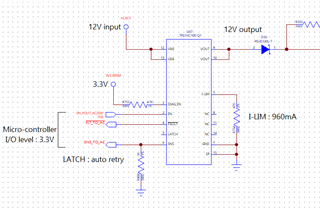Part Number: TPS1HC100B-Q1
1. Rsns setting.
2. Rlim. setting.
3. LATCH setting (auto-retry setting)

This thread has been locked.
If you have a related question, please click the "Ask a related question" button in the top right corner. The newly created question will be automatically linked to this question.
Part Number: TPS1HC100B-Q1
1. Rsns setting.
2. Rlim. setting.
3. LATCH setting (auto-retry setting)

Hi Kijung,
I have a few comments:
1. The CL is set approximately to 960mA as expected.
2. The latch is unused and so the device will auto retry after a fault
3. Diag_En is set to 3.3V which means the SNS scaling is set to 3.3V max
4. Fault is an open drain pin. This means that it will pull down to GND or is floating. As such, a pull up resistor to a power rail may be necessary to get logic level high for the controller.
5. The SNS resistor used here is only 1k. This means that the sns current flowing out of the pin will be less than 1mA. As a result, the linear voltage range seen will be quite small. It may be possible for you to increase your R_sns and get a wider range which will give you a better representation of the load current. As mentioned earlier, the fault voltage on this pin will be clamped to 3.3V (max 3.82V).
6. Output schottkey is acceptable for reverse current protection
7. You may want to use some input and output capacitors to stabilize your rails if required.
8. For EN, FAULT and SNS (any pin going to the controller) it is beneficial to also use a protection resistor but not required.
Thanks,
Shreyas